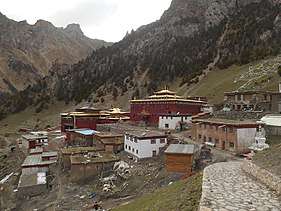Nangqên County
| Nangqên County 囊谦县 · ནང་ཆེན་རྫོང་། | |
|---|---|
| County | |
.png) Location of Nangqên County (red) within Yushu Prefecture (yellow) and Qinghai | |
| Coordinates: 32°12′11″N 96°28′52″E / 32.203°N 96.481°ECoordinates: 32°12′11″N 96°28′52″E / 32.203°N 96.481°E | |
| Country | People's Republic of China |
| Province | Qinghai |
| Autonomous prefecture | Yushu |
| Time zone | UTC+8 (China Standard) |
Nangqên County, or Nangchen (Tibetan: ནང་ཆེན་རྫོང་།, Wylie: nang chen rdzong, ZYPY: Nangqên Zong ) or Nangqian County (simplified Chinese: 囊谦县; traditional Chinese: 囊謙縣; pinyin: Nángqiān Xiàn), is a county of the Yushu Tibetan Autonomous Prefecture and is the southernmost county-level division of Qinghai province, China, bordering the Tibet Autonomous Region to the south. It was one of the five kingdoms of the historical region of Kham.
The county seat is Xangda (shor mda’ / Template:Zh-Latn 香达镇), built in a side valley and on the right bank of the Dza Chu (upper reaches of the Mekong). In 2000, the county's population amounted to 57,387 people, inhabiting a surface of 11,539 km2 (4,455 sq mi).
History

The county's name is derived from the former king (nang chen rgyal po) and kingdom of Nangchen, a tribal confederation that adhered to the Chinese government of Gansu (after 1928 to newly established Qinghai province), but was highly autonomous. The present-day's county comprises the core area of that kingdom.
A Yelpa Kagyu monastery, Tana Monastery (Jang Tana), was founded by Yelpa Yeshe Tsek in 1068. It is considered a branch monastery of Tsurpu.[1][2][3][4]
Administrative divisions
Nangqên is divided into one town and 9 townships:
- Xiangda Town (香达镇)
- Niangla Township (娘拉乡)
- Maozhuang Township (毛庄乡)
- Juela Township (觉拉乡)
- Zhexiao Township (着晓乡)
- Dongba Township (东坝乡)
- Jinisai Township (吉尼赛乡)
- Jizha Township (癿扎乡)
- Jiequ Township (吉曲乡)
- Gayong Township (尕涌乡)
Transportation
References
- ↑ "Jang Tana". The Treasury of Lives. Retrieved 2017-08-05.
- ↑ "Tana Sengge Nam Dzong" - the Monastery of Ling, in: Andreas Gruschke, The Cultural Monuments of Tibet’s Outer Provinces: Kham vol. 2 - The Qinghai Part of Kham (Yushu Autonomous Prefecture), Bangkok 2004, pp.110-115.
- ↑ Tanma Jamyang Tsultrim: "Cultural Relics of the Tana Monastery in Yushu and Gesar", in: Tibet Studies, 1991, No.1, S. 184-190.
- ↑ Tana monastery, (towards) Ji'nyinsib, Qinghai, CN. Mapping Buddhist Monasteries, accesssed August 5, 2017.